|
|
Observation
Talk involving the
inevitability of a credit cycle collapse is beginning to sound almost
second nature to many analysts. Though bearish sentiment comes nowhere
near the generally visible bullish sentiment, within the bearish camp
arguments are beginning to surface about how, not whether, the cycle will
unravel. Indeed, the debate between an inflationary outcome and a deflationary
one, almost as a rule, discounts a market collapse.
Wall Street bulls have been taunting the FOMC, perhaps trying to set the
Greenspan Fed up for a fall by moving equity prices higher in thin market
conditions, ahead of the FOMC meeting this past week. If the committee
had raised interest rates and buckled the stock market, then the bulls
would have gotten their scapegoat all the while knowing that the Fed Chairman
is not going to take the fall anyhow. As the FOMC did not move on interest
rates and the stock bulls try to take this equity market off into new
territory, Greenspan may have to spoil the party later at any rate, as
the extra stimulus during an election campaign may be to hot for the general
inflation indicators to handle.
Besides, it is way too early for the stock market to start anything that
might resemble even a more moderate price trend, because the hoped for
fundamentals have not yet crystallized, nor solidified, and because the
excess has not yet been purged! There is too much inertia in this market
for a new "sustainable" leg to develop, without something completely unexpected
to arrive, like for example, a cure for cancer. Wouldn't that be something?
In our view, however, it is more appropriate to reconcile the loud bullish
hype with the lousy general momentum, conspicuously expensive valuations,
and dearth of liquidity. Perhaps it is also correct to consider the growing
skepticism in the psychology of the market? Last year's stealth bear market,
doubtless did much damage to investor's wallets and psychology. Perhaps,
the sheep have already been fleeced.
Is
the Fed friendly, or not
Even as the bulls scream slowdown, bloody slowdown, Wall Street's arrogance
about the Fed will have to face a new reality - that the Greenspan Fed
is not as friendly as it may appear. At least we hope not. For when the
time comes to defend the integrity of the reserve currency, Greenspan
may have to raise interest rates even as the bulls are on their knees…even
as this slowdown turns into a steep dive in equity prices and the economy.
For now, the bulls have got his faith in the productivity argument, as
feeble as it may in fact be. If it is at some point revealed that his
faith in the productivity argument has somehow compromised monetary policy,
hell hath no fury as to what will happen to the international reserve
currency of the world. Hopefully, closer to the truth may be, that he
has embraced this argument as he tries to prepare the financial system
for the inevitable breakdown, in another classic Greenspan sterilizing
coup.
Nobody saw this coming
When a consensus finally develops that the oil crisis is not OPEC's fault,
nor any other evil empire's doing, attention will have to come back to
US/global monetary policy and its substantial contribution to the misfiring
of the price mechanism in energy market1.
How is it possible that this was not foreseen? I remember watching my
ticker literally explode in front of my own eyes in February 1999 on news
that was about to be the first in a long run of bullish API and DOE announcements.
Energy demand would begin blowing past any and all reasonable expectation
sets. Crude rallied hard off of its lows near $10, and within a month,
flew right through $15.
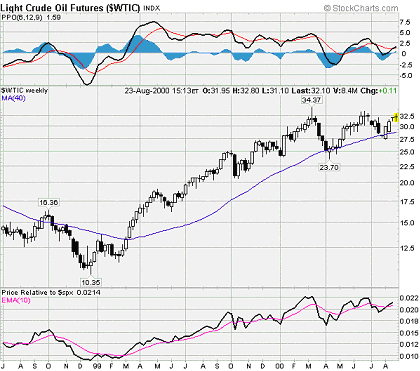 Light Crude Oil Futures |
As
I stood up to reveal my excitement that glorious day, our prestigious
captain asserted his leadership and said that we were too sophisticated
to trade in that old economy bull$#&^. At the time, you see, talk was
beginning to surface that oil has become irrelevant to the new economy,
that OPEC will imminently dissolve, and therefore, that the price of a
barrel of oil will be no more than a morning cup of coffee at an ESSO
gas station. Delirium had set in.
As Crude prices pushed through $17 not two months later, commentators
and quasi-economists began blaming the "unfriendly" influence from OPEC's
production cutbacks as the culprit. This was not called for, they clamored!
Since then, prices have nearly doubled. It wasn't until only a few months
ago now, that the market had begun to appreciate the enormous demand that
has actually been straining global production capacity. Up until then,
the focus was largely on supply cutbacks. Remember, it is now only 18
short months since $11 Crude.
What kept fooling the pro's
on the way up?
They had learned to rely on efficient market assumptions, and hence, take
their signals from what was happening in the markets, as we all have.
At the time, the price mechanism pointed toward abundant supplies of oil
relative to demand. Indeed, after the Asian economy first got the flu
in 1997 to when it spread to Russia in the fall of 1998, excess oil supply
was offered at fire sale prices to the global importer with the most purchasing
power. Ergo, the dollar price of oil collapsed, which not only fueled
the babble, but it also dissuaded oil producers from wasting money on
new exploration and investment. What's more, the whole experience has
played havoc with energy users whose business models are built on expectations
for the cost of energy products going forward.
So much
for the efficient market hypothesis
Has the oil price mechanism become dysfunctional somehow? We now know
that certain collapsing global currencies were clearly behind the collapse
in Asian demand in 1997, and European demand in 1998. We have assumed
that the fault can only be theirs.
At the other end of that rainbow, however, is a strong dollar policy.
The same one that is responsible for collapsing gold prices; The same
one that is responsible for our new economy delusions and virtuous investment
cycle; The same one that has been responsible for inflating consumer's
purchasing power and simultaneously hiding the excess consumption; The
same one that has now inflated global financial markets and economies,
through a global wealth effect double whammy - inflated US financial assets
and the rising exchange value of the dollar; The same one that is responsible
for the cumulative economic imbalances, unmistakable in the nation's balance
of payments accounts. As likely as the strong dollar policy has created
such tentative prosperity, it is likely that such a policy is also at
the root of the increasingly calculable propensity to import,
as well as the propensity for capital to traditionally flow
into dollars.
Due to the apparent rise in time preference for both, consumption and
capital, it is conceivable that capital has been allocated more and more
toward shorter, seemingly more profitable, production processes, and that
consumers are more and more spending an uncertain future. This whole process
is not only likely to engender the economic imbalances mentioned in the
previous paragraph, but also to eventually thin the nation's capital structure,
rather than deepen it. Sorry, I am counting as capital neither the goodwill
nor the intellectual property that is valued in inflated dollars today.
In short, this structure is unstable and inflationary.
In dollars anyway, oil prices seemed on the surface to confirm the new
economy delusion by late 1998, at least until the Greenspan Fed threw
caution to the wind and put the pedal to the medal in the fall of that
year. By doing so, he created this unstable, paper inflation induced,
global demand for real goods - big surprise. Now, on the verge of a potential
reversal in dollar prosperity, the prospect of an oil shortage is becoming
an incredibly precarious state of affairs.
Do not worry; the bulls claim that we have got our economic slowdown,
blah, blah, and blah. Whatever will be the ultimate trigger for gold prices,
when the consensus develops (as it already is beginning to) that our entire
monetary arrangement is at the root of many economic dislocations, look
out paper wonderland.
On Wednesday,
"OPEC said it would increase oil output 500,000 barrels a day only
if the so-called OPEC basket price -- the average price of six crude grades
produced by OPEC members and one crude pumped by Mexico -- breaches $28
a barrel for 20 consecutive days. Prices exceeded $28 a barrel on six
consecutive days through Monday, Aug. 21, the last time OPEC updated its
basket price. "Adding 500,000 barrels a day is not enough, OPEC has to
increase output by at least another 1 million barrels a day'' to meet
current demand, said Lee at Hyundai Oil." - Bloomberg news Wednesday
August 23 2000
Sounds as if the market is screaming for oil!
New Highs for the NYSE composite
As tout television turns the hype machine towards the new highs in one
index or another, it may be worthwhile to get a second opinion. The New
York Stock Exchange Composite index is one of these. The ticker's push
to new highs is the validation that the bulls think that they need, and
that they hope will bring in more money.
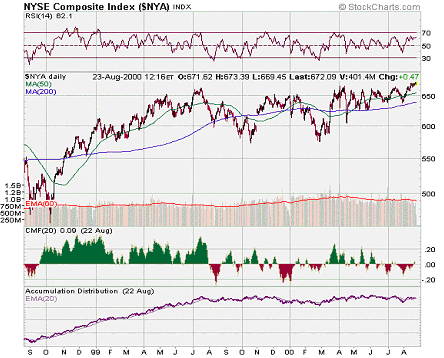 NYSE Composite Index |
Allow me, however, to point out some valid objections about the legitimacy
of this move. Clearly, any technician ought to first worry about the declining
volume and questionable momentum, accompanying such a bullish break out
to new highs.
Of particular interest, are the money flow data and the accumulation/distribution
line (a volume weighted stochastic) at the bottom of the above chart.
Considering that the index has gained 18% since March, and is off to new
highs, it is remarkable that there is a conspicuous lack of meaningful
accumulation.
To be fair, the improved breadth, illustrated below by the NYSE Advance/Decline
Line, however, provides some encouragement to the bulls. Before jumping
on the bandwagon, though, permit me to discuss the goings on in the other
markets, indexes, and in overall stock market psychology.
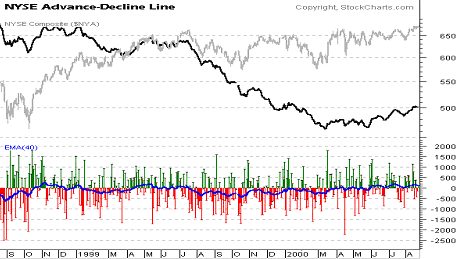 NYSE Advance-Decline Line |
Which one
is not like the other?
A bull move that is broadening out, quietly, on declining volume, on a
decline in momentum, and on insider distributions is not the same as a
bull move that is broadening out loudly, on rising volume, rising momentum
and unambiguous signs of accumulation.
The latter example was plainly evident in the fourth quarter of 1998,
in all of the indexes. Perhaps this year we will have a "stealth" bull
market -- an invisible bull market -- where more and more stocks rise,
while the indexes do nothing.
Still, I would argue that is the best-case scenario. Observe the softer
and softer bounces off of the 200-day (blue) moving average for the broad
blue chip S&P 500 index below, within what may turn out to be a massive
rising wedge, in hindsight of course.
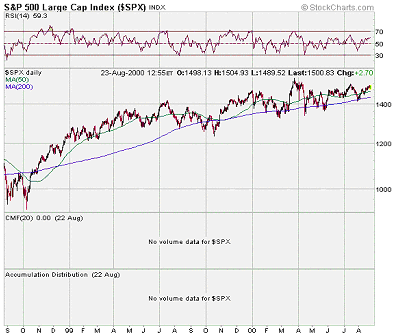 S&P 500 Index |
It
has been a couple of weeks now, since the late July sell off in the Nasdaq
Composite that upset the bullish cause, and the bulls have not answered
the call. The 200-day moving average appears to be an ever more insurmountable
resistance point now, and a bottom has yet to be established.
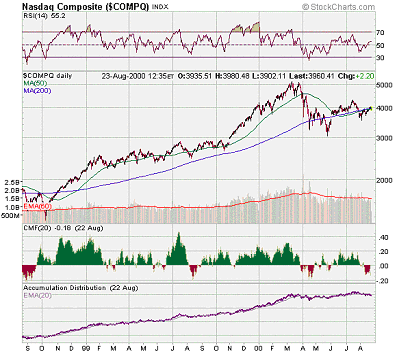 Nasdaq Composite |
We just cannot
get away from the Dollar…
Looking at the charts of the long bond below, it appears that bond traders
do not fear the prospect for "new highs" in stock prices, as they push
yields lower and prices higher. In a sense then, the "move" hasn't been
confirmed.
 30 Year US Treasury Bond Price |
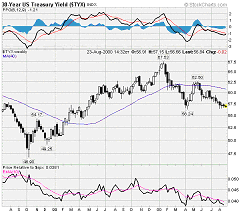 30 Year US Treasury Bond Yield |
Not even new highs in energy prices and the prospect for an energy crisis
this winter reflect in any credit market anxiety. Perhaps the explanation
lies elsewhere. There is no question that some of this is related to Treasury
buybacks, but a "seasonal" economic slowdown accompanied by an energy
crisis, tight labor market, and potentially rising asset prices, is not
the stuff that lower interest rates are generally made of. That leaves
few possibilities to explain the bullish sentiment in bonds, other than
it is prophetic of a hard global landing where the dollar is expected
to benefit as the currency of last resort. Of course, this assumes that
foreign dollar buyers are not yet sick of buying dollars at the expense
of their own economic freedom.
The fate of the long bond does without a doubt rest with the fate of the
dollar. Looking at the yield (the inverse of the bond price on the right
chart above), it appears that long-term interest rates are at a critical
inflection point. A move in either direction would have significance.
A break out in the dollar/yen AND the dollar/euro to new highs could easily
take the bond with it (and push the yield lower), but dollar/yen just
whipped back off of resistance on a growing consensus that the stronger
Yen will not hurt the Japanese economy.
"Ichizo Ohara, a senior ruling party member, said the Japanese economy
could withstand a rise in the yen even though a stronger currency raises
the cost of exports. He also said another interest- rate increase from
the Bank of Japan, which boosted rates a quarter-point this month, `wouldn't
be surprising'' - Bloomberg news; August 23 2000.
I am beginning to sense the implication that it might even bring with
it, prosperity. Is it possible, that the Japanese are vying for a slice
of this virtuous cycle that has benefited the Americans for so long? Yes.
As I mentioned in Inflation
versus Deflation, Bank of Japan Governor Hayami said as much in a
recent speech in Tokyo (July 14)2.
In fact, it might be possible that the influx of capital may strengthen
the Japanese banking system, or as Ludwig von Mises would say, deepen
its capital structure - which already seems to be on the agenda. Hayami
alludes to both, capital depth and the virtuous cycle, in his speech.
Equity prices in Japan sure liked the news, as they quickly reversed what
looked like a new low.
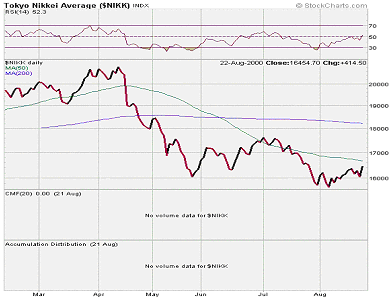 Tokyo Nikkei Average |
Dollar/euro, on the other hand, still looks firmly in check. The consensus
that is developing is that the ECB is stuck. Economies on the periphery
appear to be overheating, while the big German economy remains sluggish.
A rise in interest rates may topple the German economy and tear down the
Euro zone with it, it is feared on the one hand. However, benign neglect
of the inflationary processes, which are building due to the weakening
of the exchange rate of the currency, are extremely harmful to a "new"
currency arrangement, unfortunately.
Will the
ECB raise its key rate?
Hence, the ECB faces the first test of its main criticism: can it handle
the diverse politics, with respect to interest rate policy, to the benefit
of the common currency?
Checking with the ECB, I found that M1 has grown 6.79% year over year
through June, but has declined for the last three months of that period.
Inflation data is sporadic through the EMU, with high inflation rates
in Ireland, and other member countries, pushing EMU inflation rates above
target for the entire Euro zone. Yet, the broader aggregates (M2 and M3)
have grown below target (year over year through June), making it a tougher
call at its meeting at month end.
The FTSE and a slight buckle in the French CAC Index, which may make it
an even tougher call, are leading equity markets in Euroland, lower.
That being said, it is the currency that is important, and unless they
have been "persuaded" to leave interest rate policy alone at month end,
the ECB ought to take a stand on the need for a stable monetary unit of
account, especially after so much criticism of US monetary policy. The
neutral FOMC decision ought to make it easy for the ECB to affect a small
rate increase, which may be just enough to firm up the Euro currency.
So, it appears that with the Dollar/Euro and the Treasury bond yield,
both at an inflection point, it is perhaps up to the ECB to determine
their resolution, at least in the short term. Regrettably, currency markets
may already be discounting a stand still on interest rates. If it turns
out to be the case, I might be tempted to conclude that the ECB is simply
looking out for their dollar interests.
Ominous
signs for the consumer
Durable goods down 12% in July! Wall Street will have you believe that
the consumer is just taking a breather, but the bulk of the evidence couldn't
be more unsupportive of that nonsense.
 S&P Retail Index |
 US Gross Private Savings |
Last year's stealth bear market, it is my contention, damaged some stock
market psychology through a not insignificant contraction in net worth
(right chart above). It not only gradually undermined the greater fool
psychology that many bulls presume still exists, but perhaps also, it
holds ominous signs for the future of a consumer who has increasingly
leveraged his or her contracting net worth.
How many times have you seen this chart?
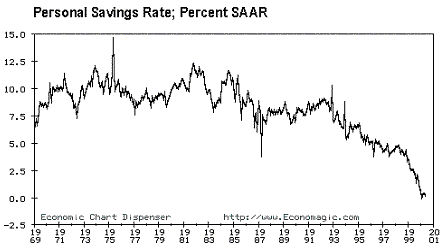 |
What
do you think will happen to wage demands, if an energy shortage this winter
crowds out excess disposable income, if declining stock prices render
stock options inadequate as a remuneration option, and if rising interest
rates begin to force higher debt service maintenance? It could result
in recession, but what of inflation?
That depends upon how you look at it. The general price level is not yet
rising out of control, but that can happen easily in an economic system
that encourages inflationary policies. Defined in terms of the purchasing
power of the dollar, with respect to its ability to buy real goods, the
inflation process is well under way.
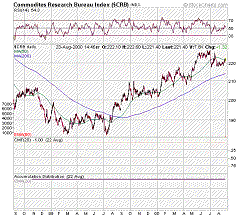 Commodity Research Bureau Index |
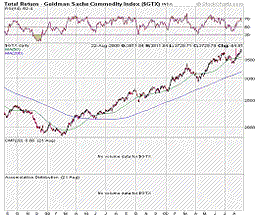 Goldman Sachs Commodity Index - Total Return |
Back to the Stock Market
As the summer doldrums rapidly approach an end, it may be useful to evaluate
who is trying to dominate today's market leadership. In the soaring financial
index, Citigroup, sporting a healthy 23 multiple, is emerging as a strong
candidate, while Merrill Lynch, with a 19 multiple, has more than doubled
in less than a year.
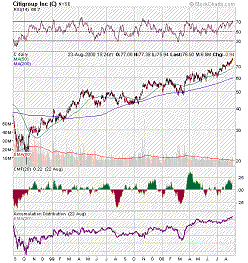 Citigroup |
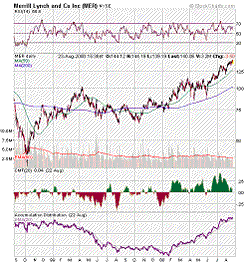 Merrill Lynch |
How about a deal on American Express at almost 30 times earnings? Or Goldman
Sachs, which has now taken a run at its old high, offering each share
at almost 20 times earnings, as they made a killing on recent AT&T financings.
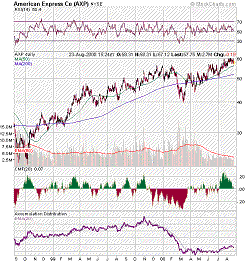 American Express |
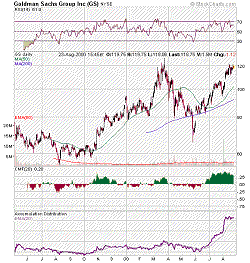 Goldman Sachs |
Even JP Morgan, the cheapest of the group at slightly over 13 times earnings,
is breaking out now. Ever since UBS' curious acquisition of PaineWebber,
there has been mounting merger and acquisition speculation building on
top of an expectation set that sees a peak in short term US interest rates
this fall.
Additionally, Citigroup, Goldman Sachs, and I believe JPM as well; have
been active in capitalizing on the cheaper credit sources overseas. Masquerading
as help in the development of Japan and Hong Kong's debt markets, Citigroup
has already offered to issue something like 400 Billion Yen in Samurai
debt (the terms are fixed in Yen) at a fraction of the cost that it would
have to pay to access US debt markets for capital. Instead of trying to
re-ignite the Yen-carry trade, shouldn't they be thinking about the potential
for bad debt problems in their loan portfolios at home?
Wait a minute though. They have probably already securitized and dumped
the lower quality stuff onto the money market for foreign interests to
accumulate.
Thank goodness for the opportunity to place the burden on the dollar.
Further comfort, in terms of earnings that is, can be taken to heart as
the banking industry has already been expensing their potential bad loans.
Yet, the lower quality of debt being issued today, and the industry-rising
exposure to the already volatile Dollar/Yen rate ought to raise some red
flags. Consider that the M&A speculation, assumptions about interest rates,
aggressive financial management, and riskier (but cyclically profitable)
loan portfolios are as equally likely to explain the momentum in financial
stocks, as they are likely to precipitate the onset of an inevitable cycle
downturn.
Chips, Technology, and Biotechnology
Intel ardently wants to take another run at the leadership position in
the chip sector, offering investors a bargain at 55 times earnings. Look
at that beautiful chart with higher highs and higher lows.
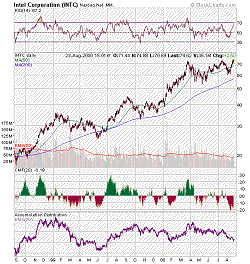 Intel Corporation |
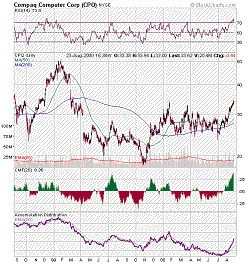 Compaq Computer |
However, I would be concerned about the visibly declining volume and what
appears to be distribution. This could be explained either by short sellers
who haven't figured out that there may be too many of them, or net sellers
that are well learned about selling into strength. I guess they aren't
holding their breath about the success of Intel's new chip, in any event.
No sign of distribution appears in Compaq's shares, however, and this
is about as good a quality breakaway attempt as I have recently seen.
The bullish chart signals going off in Compaq's shares at 50 times earnings
possibly reflect investor expectations that Intel's new chip will drive
new computer sales going forward. But that industry-bullish theme does
not seem to reflect in its competitor's share prices so far. If Compaq
can deliver on nearby news, however, it might energize this theme, and…Olč,
Olč. Or, so is the bullish wet dream perhaps.
Speaking about expectations for stronger technology investment spending
looking forward, check out this beauty at 115 times earnings. Great momentum,
but…
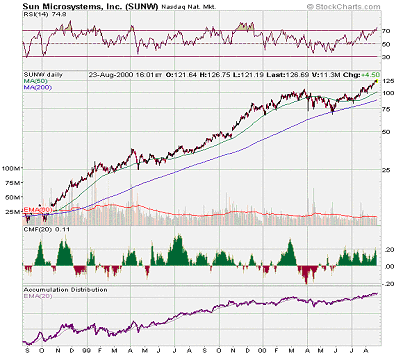 SUN Microsystems |
…do investors have any concept of how big this company will need to become
in order to support such a monstrous valuation? The stock is a little
shy on volume and momentum, but otherwise certainly deserving as a candidate
for the title, leader.
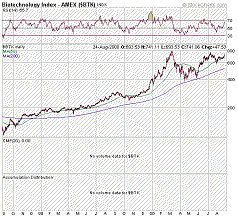 AMEX Biotech Index |
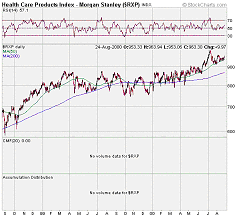 Health Care Products Index |
In the Biotech index, somewhere is President Clinton's dream to reign
over a cure for cancer. Now, if anything can outdo the Internet bubble,
it would be this. Accordingly, if anything can justify further currency
abuse, it is also this. Don't hold your breath on the former.
Old economy
cyclicals
Energy stocks look sharp, but the money flow indicators have been relatively
bearish throughout the six-month rally.
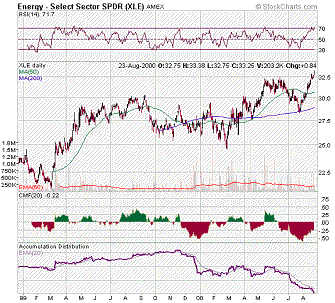 AMEX Energy - Select Sector |
 General Electric |
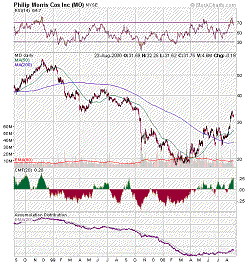 Philip Morris |
Of course, you could not have a bull market without confirmation from
the almighty GE, who brings all sorts of good things to life. A 50 multiple
is easy to assign a company whose aggressive financial group, GE Capital,
has gradually dominated the company's revenues. What's more, GE has got
new leadership.
It almost looks as if the worst is over for Philip Morris. In fact, at
nine times earnings and a 6% dividend, perhaps it is time to encourage
smoking again?
Speaking of dividends, have a look at the utility index, which certainly
has a large interest rate component to consider. More than that, however,
today speculators have begun to view these companies with a technology/growth
spin.
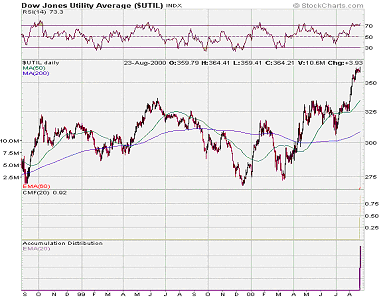 Dow Jones Utility Average |
Certainly, the basic assumption going into justifying these multiples
rests on the case for a peak in interest rates. That is the bullish case.
Since there are many more bearish charts than bullish ones, I chose to
avoid displaying that fact, but rather to provide you with an analysis
of the bulls that are vying for September leadership status.
What can we make of all this? Expensive old economy cyclical stocks are
competing with expensive old story growth stocks for the prestigious spotlight,
without any sort of resolution on the increasingly imminent affairs; interest
rates, inflation, credit decay, trade imbalances, an energy crisis, a
potential profit slowdown, the productivity argument, and of course, a
new young President.
Have a nice Labor Day, next weekend. I will be enjoying my honeymoon
until September 11, 2000. Maybe some of these topics will have been resolved
by then.
Ed Bugos
1. See Jude Wanniski's argument
2.
The
BIS Review
All charts courtesy of StockCharts
and Economagic
The
GoldenBar Report is not a registered advisory service and does not give
investment advice. Our comments are an expression of opinion only and
should not be construed in any manner whatsoever as recommendations to
buy or sell a stock, option, future, bond, commodity or any other financial
instrument at any time. While we believe our statements to be true, they
always depend on the reliability of our own credible sources. Of course,
we recommend that you consult with a qualified investment advisor, one
licensed by appropriate regulatory agencies in your legal jurisdiction,
before making any investment decisions, and barring that, we encourage
you to confirm the facts on your own before making important investment
commitments.
|